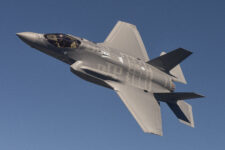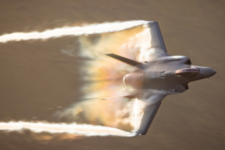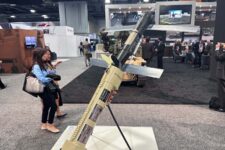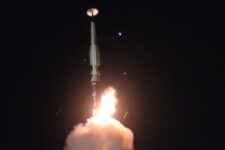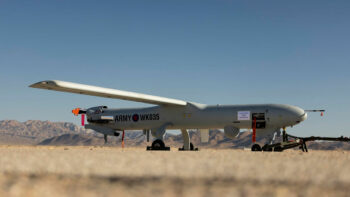
US Army air defenders with Alpha Battery, 5th Battalion, 4th Air Defense Artillery Regiment, reloads ammo during a M-SHORAD live fire on Feb. 9, 2023, at Grafenwoehr. (US Army photos by Pfc. Yesenia Cadavid)
This story was updated on 6/18/24 at 5:15 pm EST with additional information from the Army about the retrofit timeline.
EUROSATORY — The US Army is planning to replace the Longbow Hellfire missile launcher currently installed on Stryker-based M-SHORAD systems, but for now a pair of American soldiers said that using the air defense feature simply isn’t an option.
“That Hellfire right here on the left side, it doesn’t work very well with the system,” one of the Army soldiers attending Eurosatory in Paris told Breaking Defense Monday.
“We will not use a Hellfire,” the second soldier added.
Both men serve in an air defense unit based in Germany and their platoon currently has six M-SHORAD (Maneuver-Short Range Air Defense) vehicles — recently renamed Sergeant Stout. As it turns out, the platoon can’t use the Longbow Hellfire to target aircraft because the Army “prohibited” its use and did not continue fielding the modified vehicle with the rounds, Army acquisition head Doug Bush told Breaking Defense today.
The reason? After greenlighting M-SHORAD production, the service discovered that sticking the higher-tech weapon on the side of the vehicle created wear and tear on the missile, leading to “potential” safety concerns, Bush said.
“The Hellfire was not designed to be driven around in a ground vehicle,” he said.
But instead of halting production, the Army stopped soldiers from launching Hellfire missiles from the Sgt. Stout and stopped delivering them to those units.
While that disclosure is new, the Army’s decision to remove Hellfire from the new air defense weapon is not.
For the initial M-SHORAD configuration, General Dynamics Land Systems serves as the program lead integrating in Leonardo DRS’s mission equipment package with Moog’s Reconfigurable Integrated-weapons Platform (RIwP) turret and Rada USA’s Multi-Mission Hemispheric Radar onto Stryker A1 vehicles.
That initial modified turret includes a M299 launcher for two AGM-114L Longbow Hellfire missiles on one side of the vehicle that can go after larger targets, possibly armored, and on the other side is a Raytheon Stinger Vehicle Universal Launcher (SVUL) for four surface-to-air missiles suited for faster, lower flying threats. Northrop Grumman’s XM914 30 mm Bushmaster Chain Gun, and an M240 7.62 mm machine gun is also on the turret.
So far, the service has a directed requirement for 162 M-SHORADS to support training and fielding for four battalions, and so far, three of those units have received the new system, Brig. Gen. Frank Lozano, the Program Executive Officer for Missiles and Space, told reporters last week
The plan, now, is to retrofit those existing M-SHORAD platforms by swapping out the Hellfire launcher and for a second Stinger pod — a move that would give soldiers eight Stinger rounds.
But in order to move out with the plan, the Army first needs to buy more Stinger Vehicle Universal Launchers, a move the fiscal 2025 budget request includes. Lozano’s office told Breaking Defense that if the plan holds, vehicles will begin being upgraded in late fiscal 2026. That configuration change means vehicles still rolling off the production line will have the dual Stinger launchers, while vehicles already with soldiers will receive the retrofit at their fielded locations.
In the meantime, the Army is also eyeing a future Increment 3 upgrade separate than this change. (Increment 1 is the baseline configuration, Increment 2 a separate initiative involving a Stryker-mounted 50-kilowatt laser prototype and Increment 3 upgrades the Increment 1’s kinetic systems.)
For that future Increment 3, the service wants to incorporate the FIM-92 Stinger replacement missile—called the Next Generation Short Range Interceptor—onto the baseline design. The 30-millimeter cannons will also receive XM 1223 Multi-Mode Proximity Airburst munition (MMPA), to use against air, ground, and personnel targets.
In order for the Army to move out with that plan, it must pick a supplier for the Stinger replacement. Currently Lockheed Martin and RTX are vying for that title and nearing the end of the first year of the competition, Lozano said. The plan, he added, is to keep both vendors on contract for another two years, host a shoot off and pick and winner.
If that plan and M-SHORAD Increment 3 development stays on track, the service could begin live fire testing and evaluation with the upgraded air defense weapon in 2028.
